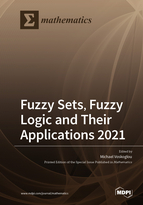Fuzzy Sets, Fuzzy Logic and Their Applications 2021
A special issue of Mathematics (ISSN 2227-7390). This special issue belongs to the section "Fuzzy Sets, Systems and Decision Making".
Deadline for manuscript submissions: closed (1 January 2023) | Viewed by 25780
Special Issue Editor
Interests: fuzzy sets and logic; Markov chains; abstract and linear algebra; artificial intelligence; mathematics education
Special Issues, Collections and Topics in MDPI journals
Special Issue Information
Dear Colleagues,
A few years ago, probability theory was a unique tool in hands of the experts dealing with situations of uncertainty appearing in problems of science and in everyday life. However, nowadays, with the development of fuzzy set theory—introduced by Zadeh in 1965—and the extension of fuzzy logic, the situation has changed. In fact, these new mathematical tools provided scientists with the opportunity to model under conditions that are vague or not precisely defined, thus succeeding in mathematically solving problems whose statements are expressed in our natural language. As a result, the spectrum of application has been rapidly extended, covering all of the physical sciences, economics and management, expert systems like financial planners, diagnostic, meteorological, information retrieval, control systems, etc., industry, robotics, decision making, programming, medicine, biology, humanities, education and almost all the other sectors of the human activity, including human reasoning itself. The first major commercial application of fuzzy logic was in cement kiln control (Zadeh, 1983), followed by a navigation system for automatic cars, a fuzzy controller for the automatic operation of trains, laboratory level controllers, controllers for robot vision, graphics, controllers for automated police sketchers and many others. It should be mentioned that fuzzy mathematics has been also significantly developed on the theoretical level, providing important insights even to branches of the classical mathematics, like algebra, analysis, geometry, etc.
The target of the present Special Issue of the MDPI journal Mathematics is to provide the experts in the field (academics, researchers, practitioners, etc.) the opportunity to present recent theoretical advances on fuzzy sets and fuzzy logic and of their extension/generalization (e.g. intuitionistic fuzzy logic, neurosophic sets, etc.) and their applications to all fields of human activity.
Prof. Dr. Michael Voskoglou
Guest Editor
Manuscript Submission Information
Manuscripts should be submitted online at www.mdpi.com by registering and logging in to this website. Once you are registered, click here to go to the submission form. Manuscripts can be submitted until the deadline. All submissions that pass pre-check are peer-reviewed. Accepted papers will be published continuously in the journal (as soon as accepted) and will be listed together on the special issue website. Research articles, review articles as well as short communications are invited. For planned papers, a title and short abstract (about 100 words) can be sent to the Editorial Office for announcement on this website.
Submitted manuscripts should not have been published previously, nor be under consideration for publication elsewhere (except conference proceedings papers). All manuscripts are thoroughly refereed through a single-blind peer-review process. A guide for authors and other relevant information for submission of manuscripts is available on the Instructions for Authors page. Mathematics is an international peer-reviewed open access semimonthly journal published by MDPI.
Please visit the Instructions for Authors page before submitting a manuscript. The Article Processing Charge (APC) for publication in this open access journal is 2600 CHF (Swiss Francs). Submitted papers should be well formatted and use good English. Authors may use MDPI's English editing service prior to publication or during author revisions.
Keywords
- Fuzzy Sets and their Generalizations
- Fuzzy Logic
- Defuzzification Techniques
- Fuzzy Numbers
- Uncertainty in Fuzzy Environments






